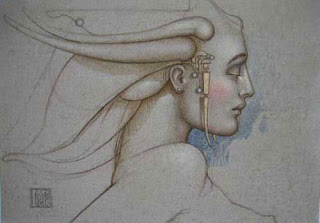I recently had the pleasure of meeting Michael Parkes and spending a wonderful weekend full of gorgeous art, inspiration and conversation hosted by the Borsini-Burr Gallery in Montara, California. Michael made himself very available throughout the weekend, generously sharing technical information about his work, spiritual insight and providing all in attendance a glimpse through a window into his world.
Michael at work in his very clean, very bright studio
My own “window” into the World of Michael Parkes began in the mid 1980s in a used bookstore in Chico, California. In the Fine Art and Illustration section, I found a book lying on the floor, laid open with a large, dusty boot print stamped across the end-papers. Saving the book from further abuse, I picked it up, brushed the dusty print from the end-papers, thankful the damage was not serious. Closing the modest volume to re-shelve it I was immediately struck by the cover – a beautiful and fantastic image of a nude female somehow engaged with a dandified Dwarf, wearing a living swan hat and pulling on a ribbon held in the mouth of a powerful tiger. I had to know more.
“Puppetmaster” 1983 Oil on Panel 50 x 65 cm
(Cover for the Leo Duppen book)
Turning to the title page I noticed this particular edition was signed by Parkes in Basel, Switzerland in 1984 – at that point I knew I had found a treasure, I just didn’t realize how much it would mean to me. Flipping through the pages I was captivated by the images – strange archetypical creatures and characters from mythology seemed to play, dance and cavort through surreal landscapes of some magical dreamworld. It felt like home to me. This was the “Duppen” book (by Leo Duppen published in 1984), the second of many books to be published on Michael’s work and his magical world.
“Mars” 1978 Oil on Panel 60 x 75 cm
“Battle of Mare Imbrium” 1983 Oil on Panel 110 x 130 cm
Since that first fascinating view his work and spiritual imagery have been a major influence for me. Parkes’ early work was rooted in the Surreal tradition, an appropriate style for communicating his metaphysical concepts and imagery, but one always felt there was more to this world. The early work was beautifully drawn, composed and rendered with an appealing sense of story and positive energy. Later influences such as Rembrandt, Alma Tadema, and Klimt became important as his work developed, but Parke’s own vision and personal mythologies always shone through. Parkes is truly a contemporary Master of multiple artistic disciplines in drawing, painting, sculpture, and stone lithography. His elegant sense of composition, idealized archetypes and otherworldly tableau’s are filled with subtle power, grace and benevolent mystery.
“Diamond Warrior” 1989 Stone Lithograph 20.75 x 26.75 inches
I use the analogy of the window because Michael uses it himself when discussing his goal as an artist – to provide access to other worlds where we can glimpse something beyond ourselves…scenes of a timeless story that exists before and after our own. Parke’s primary interest is sharing and exploring his own spiritual journey through symbolic imagery and esoteric concepts common to human culture and experience. In an interview in “Stepping Out” magazine (1988) Parkes says,
“…I paint things as beautifully as I can technically, and I paint things with love and affection so that there is a sense of beauty in the paintings. Then within that structure I can talk about almost anything I want, and people are attracted by the order and the sense of beauty in the painting. Through that, other things can come to them, with luck.”
“The Juggler” 1981 Oil on Panel 110 x 90 cm
(Michael says this painting is as close as he’s ever come to a self portrait)
(Michael says this painting is as close as he’s ever come to a self portrait)
Michael gave a fascinating and insightful presentation of his work at the Gallery on Sunday morning (last year’s presentation, “Symbols and Stillness” is highly recommended and available as a DVD from the Gallery: www.Borsini-Burr.com). This year’s body of work focused on couples, relationships and companions, but not necessarily just human. In classic Parke’s fashion one could glimpse the story of an encounter between innocent, young girl and ancient iron angel, beautiful winged angel and her guardian spirit hawk, two lovers connected and suspended by a kiss or a creative Deva bringing snow leopards into the world and sharing a bit of her own spirit with theirs.
Here are a few of my favorites from the show:
“See No Evil” 2010 Mixed Media on Vellum 5 x 13 inches
“Iron Angel” 2010 Mixed Media on Vellum 25 x 18 inches
“Daybreak” 2010 Oil on Canvas 14.75 x 35 inches
“Deva’s Garden” 2010 Oil on Canvas 24 x 38 inches
A favorite comment from Michael’s presentation echoed the much earlier interview from “Stepping Out“ magazine and gave testament to his consistency and vision, “I try to paint a world that draws the viewer in, and once inside they look around and say, ‘I’m not in Kansas any more, but I like it here…I feel comfortable…I think I’ll have a look around.’”
I certainly was aware I wasn’t in Kansas any more…it was a wonderful weekend hosted by Dianne Borsini-Burr and partner Mark Eaker and one I will always cherish. The world of Michael Parkes is truly a magical place, I hope you will take a look through the windows Michael has created and enjoy your visit to some “other” Kansas.
For information on available works, future shows, Books and DVDs contact Dianne at the Borsini-Burr Gallery in Montara-by-the-Sea: Toll free: (877) 712-211 or visit the website:
“Angel Study” Grano Lithograph 14.5 x 17.5 inches
For more information on Michael including the latest news, appearances and very interesting videos on his techniques and ideas please visit his website:





































